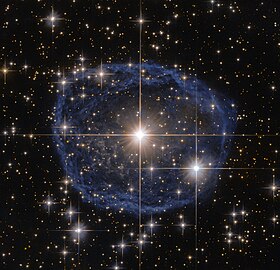WR 31a
 WR 31a is surrounded by a blue bubble nebula created by a powerful stellar wind impacting material expelled during earlier stages of the star's life (ESA/Hubble & NASA Acknowledgement: Judy Schmidt)]] Credit: ESA/Hubble & NASA Acknowledgement: Judy Schmidt | |
| Observation data Epoch J2000.0 Equinox J2000.0 | |
|---|---|
| Constellation | Carina |
| Right ascension | 10h 53m 59.586s[1] |
| Declination | −60° 26′ 44.31″[1] |
| Apparent magnitude (V) | 10.85[1] |
| Characteristics | |
| Spectral type | WN11h[2] |
| Variable type | cLBV[3] [dubious – discuss] |
| Astrometry | |
| Proper motion (μ) | RA: −3.6[1] mas/yr Dec.: 4.0[1] mas/yr |
| Distance | 8,000[2] pc |
| Absolute magnitude (MV) | −6.71[4] |
| Details[3] | |
| Mass | 45[5][dubious – discuss] M☉ |
| Luminosity | 1,820,000 [dubious – discuss] L☉ |
| Temperature | 30,200 [dubious – discuss] K |
| Other designations | |
| Database references | |
| SIMBAD | data |
WR 31a is a Wolf-Rayet star in the southern constellation of Carina that is surrounded by an expanding optical blue bubble nebula[6] Some media sources have wrongly claimed this deep-sky object was recently discovered by the Hubble Space Telescope,[7] but this nebula was originally found by Ellen Dorrit Hoffleit in 1953 and designated as the planetary nebula Hf 39.[8] Other planetary nebula catalogue names included, He 3-319, ESO 128-18, and Wray 15-682.[8]
Since 2013, the object has been considered not as a planetary nebula but rather, an expanding gas shell, formally classified as a Wolf–Rayet nebula or WR nebula.[9] Its observed expansion velocity is 365 km.s−1, estimated to be some 2.4 parsecs across.[10]
Its central highly luminous star (TYC 8928-1166-1) is invisible to the naked-eye, shining at 10.85V magnitude,[11] whose spectral type is WN11h.[10] Mass of the central star is estimated to be at least 20 times that of the Sun, and it will likely become a supernova type II event in the future.[12] Distance is estimated to be about 9,200 parsecs or 30,000 light-years.
References
- ^ a b c d e Høg, E.; Fabricius, C.; Makarov, V. V.; Urban, S.; Corbin, T.; Wycoff, G.; Bastian, U.; Schwekendiek, P.; Wicenec, A. (2000). "The Tycho-2 catalogue of the 2.5 million brightest stars". Astronomy and Astrophysics. 355: L27. Bibcode:2000A&A...355L..27H.
- ^ a b Toalá, J. A.; Guerrero, M. A.; Ramos-Larios, G.; Guzmán, V. (2015). "WISE morphological study of Wolf-Rayet nebulae". Astronomy & Astrophysics. 578: A66. arXiv:1503.06878. Bibcode:2015A&A...578A..66T. doi:10.1051/0004-6361/201525706.
- ^ a b Nazé, Y.; Rauw, G.; Hutsemékers, D. (2012). "The first X-ray survey of Galactic luminous blue variables". Astronomy & Astrophysics. 538: A47. arXiv:1111.6375. Bibcode:2012A&A...538A..47N. doi:10.1051/0004-6361/201118040.
- ^ Van Der Hucht, Karel A. (2001). "The VIIth catalogue of galactic Wolf-Rayet stars". New Astronomy Reviews. 45 (3): 135. Bibcode:2001NewAR..45..135V. doi:10.1016/S1387-6473(00)00112-3.
- ^ Smith, Nathan; Tombleson, Ryan (2015). "Luminous blue variables are antisocial: Their isolation implies that they are kicked mass gainers in binary evolution". Monthly Notices of the Royal Astronomical Society. 447: 598. arXiv:1406.7431. Bibcode:2015MNRAS.447..598S. doi:10.1093/mnras/stu2430.
{{cite journal}}: CS1 maint: unflagged free DOI (link) - ^ "Hubble's Blue Bubble". NASA. Retrieved 1 March 2016.
- ^ "Hubble Captures "Blue Bubble' Star - 20 Times Bigger, a Million Times Brighter than the Sun's". Inquisitr. Retrieved 2 March 2016.
- ^ a b "VizieR". CDS. Retrieved 2 March 2016.
- ^ Frew, D. J.; Bojicic, I. S.; Parker, Q. A. (2013). "A catalogue of integrated Hα fluxes for 1258 Galactic planetary nebulae". Monthly Notices of the Royal Astronomical Society. 431: 2. Bibcode:2013MNRAS.431....2F. doi:10.1093/mnras/sts393.
{{cite journal}}: CS1 maint: unflagged free DOI (link) - ^ a b Toalá, J. A.; Guerrero, M. A.; Ramos-Larios, G.; Guzmán, V. (2015). "WISE morphological study of Wolf-Rayet nebulae". Astronomy & Astrophysics. 578: A66. arXiv:1503.06878v1. doi:10.1051/0004-6361/201525706.
- ^ "SIMBAD". CDS. Retrieved 2 March 2016.
- ^ "Blue bubble in Carina". NASA. Retrieved 2 March 2016.
